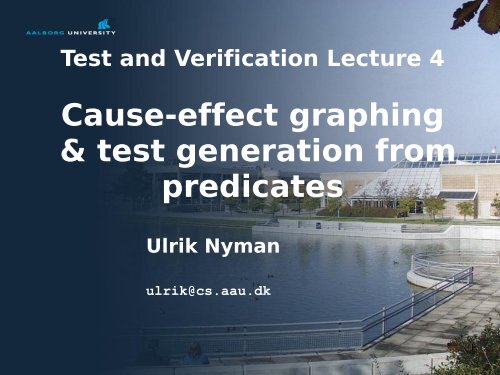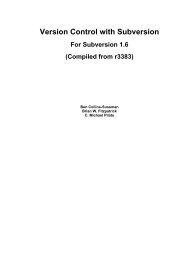Cause-effect graphing
Cause-effect graphing
Cause-effect graphing
You also want an ePaper? Increase the reach of your titles
YUMPU automatically turns print PDFs into web optimized ePapers that Google loves.
Test and Verification Lecture 4<br />
<strong>Cause</strong>-<strong>effect</strong> <strong>graphing</strong><br />
& test generation from<br />
predicates<br />
Ulrik Nyman<br />
ulrik@cs.aau.dk<br />
1
Plan for today<br />
<br />
<br />
<strong>Cause</strong>-<strong>effect</strong> <strong>graphing</strong><br />
<br />
<br />
<br />
Purpose<br />
Notation<br />
Decision table and test generation<br />
Test generation from predicates<br />
<br />
<br />
<br />
Predicates and Boolean expressions<br />
Fault model<br />
Relation to cause <strong>effect</strong> <strong>graphing</strong><br />
2
<strong>Cause</strong>-<strong>effect</strong> <strong>graphing</strong><br />
<br />
<br />
A.k.a. Dependency modeling<br />
Purpose:<br />
<br />
<br />
<br />
Model relationships between<br />
<strong>Cause</strong>s and<br />
Effects<br />
3
Steps<br />
<br />
<br />
<br />
<br />
1) Identify causes and <strong>effect</strong>s by reading<br />
requirements.<br />
2) Express relationship between causes<br />
and <strong>effect</strong>s<br />
3) Transform graph to decision table<br />
4) Generate tests from decision table<br />
4
Notation<br />
<br />
C implies Ef<br />
C<br />
Ef<br />
<br />
Not C implies Ef<br />
C<br />
Ef<br />
<br />
Ef when C1 and C2<br />
and C3<br />
C1<br />
C2<br />
^<br />
Ef<br />
C3<br />
5
Notation<br />
<br />
Ef when C1 or C2<br />
C1<br />
v<br />
Ef<br />
C2<br />
6
Notation<br />
<br />
Exclusive: either<br />
C1 or C2 or C3<br />
E<br />
C1<br />
C2<br />
C3<br />
<br />
Inclusive: at least<br />
C1 or C2<br />
I<br />
C1<br />
C2<br />
7
Notation<br />
<br />
C1 requires C2<br />
C1<br />
C2<br />
<br />
One and only one<br />
of C1 and C2<br />
O<br />
C1<br />
C2<br />
8
Notation<br />
<br />
<br />
Ef1 masks Ef2<br />
Example:<br />
<br />
<br />
<br />
Ef1: Shipping<br />
invoice<br />
Ef2: Order not<br />
shipped letter<br />
Both <strong>effect</strong>s cannot<br />
occur in the same<br />
test.<br />
Ef1<br />
Ef2<br />
9
Example<br />
<br />
<br />
<br />
Online sales system<br />
<br />
Possible configurations<br />
CPU 1, 2, 3<br />
Printer PR 1, 2<br />
Monitor M 20, 23, 30<br />
<br />
RAM 256, 512, 1G<br />
Windows: Items, Free and Price<br />
Read requirements<br />
10
Example<br />
<br />
<strong>Cause</strong>s<br />
<br />
<br />
<br />
<br />
<br />
<br />
<br />
<br />
C1: Purchase CPU1<br />
C2: Purchase CPU2<br />
C3: Purchase CPU3<br />
C4: Purchase PR1<br />
C5: Purchase PR2<br />
C6: Purchase M20<br />
C7: Purchase M23<br />
C8: Purchase M30<br />
11
Example<br />
<br />
Effects in Free display window<br />
<br />
RAM 256<br />
<br />
<br />
<br />
RAM 512 and PR1<br />
RAM 1G and PR2<br />
No giveaway with this item<br />
12
Example<br />
E<br />
C1<br />
C2<br />
Ef1<br />
C3<br />
C4<br />
v<br />
Ef2<br />
C5<br />
^<br />
Ef3<br />
R<br />
C6<br />
C7<br />
1<br />
Ef4<br />
C8<br />
13
Decision table<br />
C1 C2 C3 C4 Ef 1<br />
<br />
1 1 1 0 0 1<br />
<br />
2 0 0 1 0 1<br />
<br />
3 1 0 1 0 0<br />
<br />
4 0 1 0 1 0<br />
14
DT from CE graph<br />
<br />
<br />
<br />
CEGDT<br />
Input: <strong>Cause</strong> <strong>effect</strong> graph with<br />
<br />
<br />
C1, C2, ... CP<br />
Ef1, Ef2, ... EfQ<br />
Output:<br />
<br />
<br />
DT with P + Q rows<br />
Variable number of columns<br />
15
Steps<br />
<br />
<br />
<br />
Process Effects one by one<br />
Find combinations of causes that lead to<br />
the current Effect<br />
<br />
Possibly apply heuristics<br />
Update decision table<br />
16
Heuristics<br />
C1<br />
<br />
Or node<br />
<br />
Desired state: 0<br />
C2<br />
v<br />
Ef<br />
<br />
H1: Enumerate all<br />
combinations of inputs to<br />
C1 and C2 such that<br />
C1 = C2 = 0<br />
17
Heuristics<br />
C1<br />
<br />
Or node<br />
<br />
Desired state: 1<br />
C2<br />
v<br />
Ef<br />
<br />
H2: Enumerate all<br />
combinations of inputs to<br />
C1 and C2 other than<br />
those for which<br />
C1 = C2 = 1<br />
18
Heuristics<br />
C1<br />
<br />
And node<br />
<br />
Desired state: 0<br />
C2<br />
^<br />
Ef<br />
<br />
H3: Enumerate one<br />
combination for each of<br />
<br />
(0,0)<br />
<br />
(1,0)<br />
<br />
(0,1)<br />
19
Heuristics<br />
C1<br />
<br />
And node<br />
<br />
Desired state: 1<br />
C2<br />
^<br />
Ef<br />
<br />
H4: Enumerate all<br />
combinations on input of<br />
C1 and C2 such that<br />
C1 = C2 = 1<br />
20
Predicates<br />
<br />
<br />
<br />
Boolean expressions<br />
Bop – Boolean operator<br />
<br />
And, Or, Xor, Not<br />
Relop – Relational operator<br />
<br />
, =, =, =/=<br />
21
Singular<br />
<br />
Singular boolean expression<br />
<br />
Each literal only appears once<br />
22
Fault model<br />
<br />
Boolean operator fault<br />
<br />
<br />
<br />
Incorrect Boolean operator(s)<br />
Incorrect negation<br />
Incorrect Boolean variable<br />
23
Fault model<br />
<br />
<br />
Relational operator fault<br />
<br />
<br />
<br />
Incorrect relational operator<br />
Two relational faults<br />
Relational and boolean fault<br />
Arithmetic expression fault<br />
<br />
Off-by-* faults<br />
24
Fault model<br />
<br />
<br />
Not guaranteed to be detected<br />
<br />
<br />
Missing Boolean variable<br />
Extra Boolean variable<br />
Guaranteed to be detected<br />
<br />
<br />
Not a real “guarantee”<br />
If we arrive at the test location<br />
25
Testing criteria<br />
<br />
<br />
<br />
BOR: Boolean operator<br />
BRO: Boolean and relational operator<br />
BRE: Boolean and relational expression<br />
26
Generating<br />
<br />
We left out this part<br />
<br />
Generating BOR, BRO and BRE adequate<br />
test sets<br />
27
Fault propagation<br />
<br />
The generation algorithms ensure that<br />
certain types of faults are propagated to<br />
the root node<br />
Does not propagate<br />
N6 v true<br />
N6 v true<br />
N4 ^ true<br />
fault<br />
false<br />
N4 v true<br />
false<br />
28
Fault propagation<br />
<br />
The generation algorithms ensure that<br />
certain types of faults are propagated to<br />
the root node<br />
Does propagate<br />
N6 v false<br />
N6 v true<br />
N4 ^ false<br />
fault<br />
false<br />
N4 v false<br />
false<br />
29
CEG and Predicate testing<br />
<br />
<br />
<br />
Relationship among causes can be seen<br />
as predicates<br />
Effects can be used to generate oracle<br />
BOR-CSET vs. CEGDT<br />
<br />
<br />
BOR-CSET slightly less <strong>effect</strong>ive<br />
BOR-CSET significantly smaller test sets<br />
30
White box<br />
<br />
Program based predicate test generation<br />
<br />
In practice it is hard to find input which<br />
exercises the chosen combinations<br />
31

















